2001.08.09
| |
[The quotation below and all subsequent quotations are from R.G. Collingwood's The Idea of History. The quotations are faithful copies of the original text except wherever the word 'historian' occurred it has been replaced with the word 'architect'.]
How, or on what conditions, can the architect know the past? In considering this question, the first point to notice is that the past is never a given fact which he can apprehend empirically by perception. Ex Hypothesi, the architect is not an eyewitness of the facts he desires to know. Nor does the architect fancy that he is; he knows quite well that his only possible knowledge of the past is mediate or inferential or indirect, never empirical. The second point is that this mediation cannot be effected by testimony. The architect does not know the past by simply believing a witness who saw the events in question and has left his evidence on record. That kind of mediation would give at most not knowledge but belief, and very ill-founded and improbable belief. And the architect, once more, knows very well that this is not the way in which he proceeds; he is aware that what he does to his so-called authorities is not to believe them but to criticize them. If then the architect has no direct or empirical knowledge of them, what kind of knowledge has he: in other words, what must the architect do in order that he may know them?
R. G. Collingwood, The Idea of History (New York: Oxford University Press, 1994), p. 282.
| |
Encyclopedia Ichnographica
1999.11.07 20:54
When I read your list of the five types of design, I immediately wondered if the notion of reenactment architectures may engender a sixth category. I know that reenactment is very much related to Mimetics and even Anthropomorphics, but I also see an important distinction between the latter two and the notion of reenactment, in that reenactments are not exactly copies, nor are they reconstructions, rather they are repeated rituals that have a core essence/event that is continual but also slightly changed over time and according to present circumstances. For example, Hadrian's Villa is perhaps the first (virtual) museum of architecture and the first reenactment 'theme park', the reign of Ludwig II of Bavaria was nothing less than a reenactment of previous European absolute monarchies, Disney's Cinderella castle/Magic Kingdom (modeled after Ludwig II's Neuschwanstein Castle) is then a reenactment of a reenactment (deluxe redux redux), Princess Diana's funeral reenacted Ancient Rome's Triumphal Way in every single detail including the massive (global) crowds that watched, and Las Vegas is undoubtedly today's world capital of reenactment architectures, even to the point of synthesizing a new reenactment urbanism. Moreover, now that I think of it, Rowe and Koetter's Collage City in part very much purports reenactment architectures / urbanisms although I believe the word reenactment is never used. Even if reenactment architectures are only a subset of Mimetics, I believe that reenactment architectures will nonetheless become a predominant design methodology throughout the coming millennium. It is then towards the notion of understanding and formulating a theory of reenactment architectures that I plan to further use what Piranesi's Ichnographia of the Campus Martius teaches me.
|
 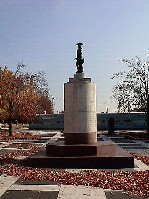 left: Venturi and Rauch, Franklin Court, 1972-76, Philadelphia. Here Benjamin Franklin's Philadelphia residence is reenacted rather than reconstructed. Although the site of Franklin's house is historically verified, the physical nature of the house is not recorded except for bits of archaeological evidence. The house is thus now presented in its true virtual condition.
left: Venturi and Rauch, Franklin Court, 1972-76, Philadelphia. Here Benjamin Franklin's Philadelphia residence is reenacted rather than reconstructed. Although the site of Franklin's house is historically verified, the physical nature of the house is not recorded except for bits of archaeological evidence. The house is thus now presented in its true virtual condition.
right: Venturi, Rauch and Scott Brown, Welcome Park, 1982, Philadelphia. The paving of Welcome Park depicts the original plan of Philadelphia; in place of the green squares a tree is planted, and in the center of the plan/park stands a pedestal and statue of William Penn. This park reenacts Philadelphia itself -- the paving reenacts the street grid, the trees reenact Philadelphia's four original squares, and the statue of William Penn reenacts Philadelphia's City Hall.
In a general way, the meaning of the conception is easily understood. When a man thinks historically, he has before him certain documents or relics of the past. His business is to discover what the past was which has left these relics behind it. For example, the relics are certain written words; and in that case he has to discover what the person who wrote those words meant by them. This means discovering the thought which he expressed by them. To discover what his thought was, the architect must think it again for himself.
R. G. Collingwood, The Idea of History (New York: Oxford University Press, 1994), p. 282-3.
| |
reenactment
1999.11.09 10:28
The evocation of Serlio's 'street scenes' is indeed apt--the notion of stage set is very much part of reenactment, i.e., the place upon which and within which to 'act' again (and again). For the record, Serlio drew three scenes, the third, Scena Rustica or Scena Satirica, is all natural/naturalistic (proto primitive hut? or proto romanticism?).
While reenactment certainly necessitates a contextual understanding, reenactment as a design paradigm is nonetheless not necessarily site specific. For example, theme parks everywhere are for the most part far removed for the 'actual' themes they reenact. On the other hand, the reenactments within Venturi (Rauch) and Scott Brown's Franklin Court (Philadelphia), Western Plaza (Wash. D.C.) and Welcome Park (Philadelphia) relate directly to their respective sites/environments. Reenactment then can (and indeed does) have it both ways in terms of context. As to the "problem" of "exciting ideas" never getting developed due to being brightly spotlighted and then quickly moved on form, perhaps this 'trendy' behavior too is a form of reenactment, that is, a repetitious renewal, the continual process of putting on a new hat, but always putting on a hat nevertheless.
The best philosophy I've read so far that purports reenactment is within Collingwood's The Idea of History. Collingwood is much influenced by Croce, and Croce is much influenced by Vico. (I have yet to do extensive reading regarding of the philosophy of history, but I have done enough to see that there is a significant strand of it that addresses reenactment as a methodology. I suspect Vico's New Science to be the most important primary source--I have the book, but have only read a small part of it so far.) When I first began to redraw Piranesi's Campo Marzio using CAD, I was doing so to get as close to Piranesi as possible; essentially, I was reenacting his act of drawing as best I could. For me, this exercise, this reenactment, has provided enormous insight, albeit it took several years of continual work for this vision to develop. I am certainly not Piranesi, nor do I contend to possess his superior creative talent and imagination, but I deliberately attempted to do some of the same things he has done, and in so doing I honestly believe I removed several degrees of separation. Perhaps reenactments then are always a play with degrees of separation, sometimes seeing how close one can get to the 'original' and/or sometimes seeing how far one can stretch the 'truth', to name the extreme cases. Play - Theater - Reenactment
My historiography of Piranesi's Campo Marzio aims to present the Ichnographia is a prime exemplar of architectural and urban design as reenactment--Piranesi's plan is not only a large architecturally drawn plan, but also a plan in the sense that it lays out a course of action, or, should I say, a course of reenaction. Taking the lessons of the Ichnographia('s virtuality) and utilizing (reEnacting!) them in today's world is the 'real' challenge.
|
Suppose, for example, he [the architect] is reading the Theodosian Code, and has before him a certain edict of an emperor. Merely reading the words and being able to translate them does not amount to knowing their historical significance. In order to do that he must envision the situation with which the emperor was trying to deal, and he must envision it as that emperor envisioned it. Then he must see for himself, just as if the emperor's situation was his own, how such a situation might be dealt with; he must see the possible alternatives, and the reasons for choosing one rather than another; and thus he must go through the process which the emperor went through in deciding on this particular course. Thus he is re-enacting in his own mind the experience of the emperor; and only in so far as he does this has he any historical knowledge, as distinct from a merely philosophical knowledge, of the meaning of the edict.
R. G. Collingwood, The Idea of History (New York: Oxford University Press, 1994), p. 283.
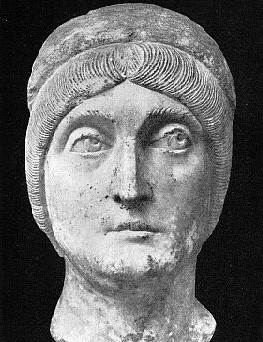
(so-called) Saint Helena
Ny-Carlsberg Glyptothek
| |
the two Elenis
1999.12.28 17:50
Two of the architects I met almost immediately in Brussels at the INSIDE DENSITY colloquium were both named Eleni--Eleni Gigantes and Eleni Kostika. We were members of the same "Thinking Density" session, and they presented their paper--Greece: Seasonal Densities, Built Density, Landscape Saturation -- the ongoing transformation of a country through tourism--after I presented my paper. Upon hearing their talk, it wasn't difficult to see that our two papers had some strong similarities in that what happened in Greece vis-à-vis 'constructed' tourism comes very close to what Piranesi did within the Campo Marzio vis-à-vis reenactment. I quickly mentioned this similarity to the two Elenis in-between two of the subsequent papers, and then, during the session break, the three of us had a lengthy discussion regarding "what is reenactment?". I used Princess Diana's funeral as an easy example of ancient Rome's triumphal way being reenacted, and also said that modern Greece may in some circumstances be trying to reenact its ancient glory as an ingredient for tourism. Eleni Kostika still questioned the notion of reenactment, however, and offered that perhaps anything (or everything?) is indeed a reenactment of something. In the midst of all this, we found ourselves talking about Thanksgiving Day in the USA (actually it was Thanksgiving Day, but we were in Brussels), and it quickly dawned on Eleni Gigantes that Thanksgiving Day is a huge reenactment (if not the biggest reenactment within the United States).
I then turned the conversation into something the two Elenis did not expect, namely my work this year involving St. Helena, and my thesis that she was the first master architect of Christianity. Eleni is the original rendition of the name Helena, and I told Eleni and Eleni that they had no idea how thrilled I was to be sitting in Brussels having just met two architects named Eleni, and to be discussing architecture and reenactment with them. Of course, I gave them a quick synopsis of my thesis, and Eleni Gigantes absorbed it all most agreeably, while Eleni Kostika seemed to remain somewhat circumspect.
Just before going to Brussels, I had come to the conclusion that for me to effectively write about St. Helena's role as first master architect of Christianity, I had to concede that I, like many before me, would be writing yet another legend of St. Helena. Today, legends are usually thought of as popular myths (with myth being the operative word), but, by its first definition, a legend is indeed the story of the life of a saint. In either case, meeting Eleni and Eleni, two woman architects, in Brussels is a big part of my legend of St. Helena.
That night, as I lay sleepless in my hotel room, I thought about the strange coincidence of meeting two Elenis, and first I thought of the 'odd' and rare double early Christian basilicas that were built towards the end of Helena's life (the last of which still stands as (the many times rebuilt) double churches in Trier, Germany). And then I wondered whether Eleni Gigantes and Eleni Kostika, since both are architects, offer any insight into St. Helena's personality. And then I wondered whether a combination of Eleni Gigantes and Eleni Kostika provides a real glimpse of St. Helena.
|
Or again, suppose he is reading a passage of an ancient philosopher. Once more, he must know the language in a philosophical sense and be able to construe; but by doing that he has not yet understood the passage as an architect of philosophy must understand it. In order to do that, he must see what the philosophical problem was, of which his author is here stating his solution. He must think that problem out for himself, see what possible solutions of it might be offered, and see why this particular philosopher chose that solution instead of another. This means re-thinking for himself the thought of his author, and nothing short of that will make him the architect of that author's philosophy.
R. G. Collingwood, The Idea of History (New York: Oxford University Press, 1994), p. 283.
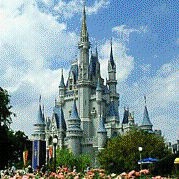
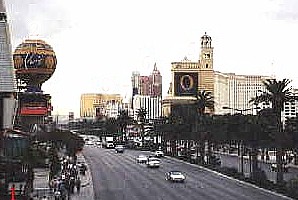

top: Cinderella's Castle, c.1970, Walt Disney World.
center: View of the Las Vegas Strip, c.2000.
bottom: Aerial view of Seaside, Florida, c.1990.
| |
reenactment
1999.12.29 16:26
Brian wonders: lauf-s, I am wondering if you've encountered Baudrillard's ideas of simulcra and simulation in relation to reenactment. I am wondering how they are similiar/different/parallel ideas.
Steve replies: As it happens, I purchased and started reading Baudrillard's Simulation and Simulacra just over a week before I went to Brussels (i.e., mid-November). I was prompted to do this when (in early November) I started reading Neil Leach's The Anaesthetics of Architecture, where, in the introduction Leach writes a good bit about Baudrillard's sim-sim ideas. I right away saw the SIMilarities to what I'm formulating re: reenactment, and thus sought out Baudrillard's book.
I've only read like the first three essays of Simulation and Simulacra, and that's now over a month ago. Of the three essays, only the first relates reasonably to reenactment; the other two essays reminded me of Barthes' Mythologies. I have to finish the book, as well as give it a more careful analysis. So, your wondering about "similar/different/parallel ideas" is right on target, and that is precisely what I intend to investigate.
The excerpt you supplied from the online source is very useful, particularly the passage:
So it is with simulation, insofar as it is opposed to representation. The latter starts from the principle that the sign and the real are equivalent (even if this equivalence is utopian, it is a fundamental axiom). Conversely, simulation starts from the utopia of this principle of equivalence, from the radical negation of the sign as value, from the sign as reversion and death sentence of every reference. Whereas representation tries to absorb simulation by interpreting it as false representation, simulation envelops the edifice of representation a itself a simulacrum. This would be the successive phases of the image:
* it is the reflection of a basic reality.
* it masks and perverts a basic reality.
* it masks the absence of a basic reality.
* it bears no relation to any reality whatever: it is its own pure simulacrum.
If I may be so bold, I'd say that the notion of reenactment is indeed missing form the above set of 'simulation', 'representation', 'sign', and 'simulacra', that is, even though what Baudrillard says here is succinct and 'correct', it might just be nonetheless incomplete because reenactment is a continuation, an ongoing affirmation of specific past 'realities'. There is more than a mere thin distinction between 'reflection' and 'ongoing affirmation' or 'continuation'. The core issue for reenactment may be the distinction between ENACTMENT and a subsequent(ly necessary by definition) REENACTMENT. Is it correct to say that, for example, Beethoven's actual composing of a symphony is the enactment of the symphony, and hence every performance of the symphony (even the first performance and regardless of the interpretive differences of the rest) is a reenactment? As I said here about a month ago, reenactment involves a play with degrees of separation, specifically degrees of separation from the original enactment (and what Baudrillard does above is essentially map out degrees of separation in the mostly negative extreme).
So far, for me at least, the notion of reenactment (especially with regard to architecture and design and the built environment in general), helps raise significant questions, the answers to which may define what reenactment is or what reenactment is not.
Is Disney's Magic Kingdom really a reenactment of the Garden of Eden (including the unavoidable temptation of capitalism) with some very carefully designed degrees of separation? Is Las Vegas really a reenactment of all that the Tree of Knowledge of Good and Evil had/has to offer? And yes, is New Urbanism really a reenactment of the WHITE (Aryan/American) DREAM?
|
Such as objector might begin by saying that the whole conception is ambiguous. It implies either too little or too much. To re-enact an experience or re-think a thought, he might argue, may mean either of two things. Either it means enacting an experience or performing an act of thought resembling the first, or it means enacting an experience or performing an act of thought literally identical with the first. But no one experience can be literally identical with another, therefore presumably the relation intended is one of resemblance only. But in that case the doctrine that we know the past by re-enacting it is only a version of the familiar and discredited copy-theory of knowledge, which vainly professes to explain how a thing (in this case an experience or act of thought) is known by saying that the knower has a copy of it in his mind. And in the second place, suppose it granted that an experience could be identically repeated, the result would only be an immediate identity between the architect and the person he was trying to understand, so far as that experience was concerned. The object (in this case the past) would be simply incorporated in the subject (in this case the present, the architect's own thought); and instead of answering the question how the past is known we should be maintaining that the past is not known, but only the present. And, it may be asked, has not Croce himself admitted this with his doctrine of the contemporaneity of history?
R. G. Collingwood, The Idea of History (New York: Oxford University Press, 1994), p. 283.
| |
enactment
2000.02.18 11:36
Brian asks (lauf-s): I wonder what the limits of reenactment are... where does reenactionary architecture begin and end?
lauf-s replies: It seems logical that no reenactment occurs without an enactment ocurring first... reenactment's most inescapable limit is that it can never be as original as that which it reenacts.
|
We now pass to the second objection. It will be said: "Has not this argument proved too much? It has shown that an act of thought can be not only performed at an instant but sustained over a lapse of time; not only sustained, but revived; not only revived in the experience of the same mind but (on pain of solipsism) re-enacted in another's. But this does not prove the possibility of history. For that, we must be able not only to re-enact another's thought but also to know that the thought we are enacting is his. But so far as we re-enact it, it becomes our own; it is merely as our own as we perform it and are aware of it in the performance; it has become subjective, but for that very reason it has ceased to be objective; become present and ceased to be past. This indeed is just what Oakeshott has explicitly maintained in his doctrine that the architect only arranges sub specie praeteritorum what is in reality his own present experience, and what Croce in effect admits when he says that all history is contemporary history.
R. G. Collingwood, The Idea of History (New York: Oxford University Press, 1994), p. 298.
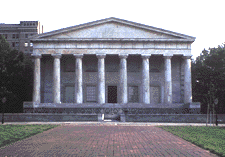
William Strickland, Second Bank of the United States, 1819-24, Philadelphia.
| |
Re: [Re:] enactment
2000.02.18 15:27
Brian asks:
Does this mean that typological architecture falls within the domain of reenactionary architecture, wherein there is a precedent / original (enactment) to be copied again and again--does originality pose any problem, such as finding the correct original from which to base the reenactment on? For example, the Parthenon has been said to be copied by bank typologies. Aesthetically, the Parthenon is not a unique building type as far as I known, it shares common traits with other Greek temple architecture, thus the problem of finding an original might be one of a mythical original or first ideal form.
How does reenactionary architecture deal with this issue?
Steve replies:
Bank is a typology.
Temple is a typology.
Greek temples are a specific category of the temple typology.
The Parthenon is a specific Greek temple.
Some, but definitely not all, banks reenact Greek temples, and probably quite a small number of banks specifically reenact the Parthenon.
Perhaps typology is basically an exercise in the reenactment of architectural abstractions.
When it come to mythical origins and first ideal forms, it is worthwhile to ask if the mythical origins and the first ideal forms are themselves reenactments. For example, the manifestation of Shiva reenacts metabolism. Moreover, might not Plato's ideal forms [like his Socratic dialogues] also be reenactments (albeit highly abstracted)? Perhaps Plato's prefect circle 'ideally' reenacts the pupils of our eyes and Plato's perfect triangle 'ideally' reenacts the nose on our face.
Perhaps all abstractions are highly idealized reenactments of reality, rather than reality being a reenactment of highly idealized abstractions.
|
To disengage ourselves from these two complementary errors, we must attack the false dilemma from which they both spring. That dilemma rests on the disjunction that thought is either pure immediacy, in which case it is inextricably involved in the flow of consciousness, or pure mediation, in which case it is utterly detached from that flow. Actually it is both immediacy and mediation. Every act of thought, as it actually happens, happens in a context out of which it arises and in which it lives, like any other experience, as an organic part of the thinker's life. Its relations with its context are not those of an item in a collection, but those of a special function in the total activity of an organism. So far, not only is the doctrine of the so-called idealist correct, but even that of the pragmatists who have developed that side of it to an extreme. But an act of thought, in addition to actually happening, is capable of sustaining itself and being revived or repeated without loss of its identity. So far, those who have opposed the 'idealists' are in the right, when they maintain that what we think is not altered by alterations of the context in which we think it. But it cannot repeat itself in vacuo, as the disembodied ghost of a past experience. However often it happens, it must always happen in some context, and the new context must be just as appropriate to it as the old. Thus, the mere fact that someone has expressed his thoughts in writing, and that we possess his works, does not enable us to understand his thoughts. In order that we may be able to do so, we must come to the reading of them prepared with an experience sufficiently like his own to make those thoughts organic to it.
R. G. Collingwood, The Idea of History (New York: Oxford University Press, 1994), p. 300.
| |
Re: urinal in a gallery
2000.03.16 21:21
Marcus wrote:
Hugh asks:
But what if (oh God) these reproduction urinals are not in fact true "readymades" but in fact carefully crafted reproductions of the original readymade that was, one imagines, long out of production since design in sanitary ware had moved on?
Where does that leave us? With something purporting to be a readymade that is actually a hand-made work of art?
which makes Steve ask:
Could it simply be that Duchamp and even his unique "art" cannot escape the varying degrees of separation that always come with reenactments, even crafty and/or dexterous reenactments?
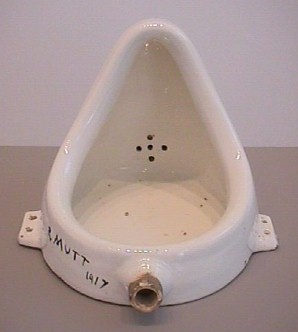
Marcel Duchamp, Fountain, c.1967 reenactment of the lost 1917 original, Philadelphia Museum of Art.
|
But this example of musical history illustrates another and an important point. No architect of music deserves the name unless he has studied for himself the old music whose growth and development he is trying to describe. He must have listened to Bach and Mozart, Palestrina and Lasso, and possess personal acquaintance with their works. This means that he must have been present at actual performances of these works either physically or in imagination; and in the latter case the imaginative power is acquired only by actually hearing similar things performed--e.g. a man who had never heard an orchestra of the Beethoven period could not read a symphony of Beethoven in score with any chance of obtaining a good imaginative hearing of it. We may therefore boldly say that the sine qua non [the one thing that is absolutely essential] of writing the history of past music is to have this past music re-enacted in the present. Just the same thing is true of other arts: e.g. we must read old poetry for ourselves, see old pictures for ourselves with the dirt of age actually or in imagination removed and the colors restored to their old values. Similarly, to write the history of a battle, we must re-think the thoughts which determined its various tactical phases: we must see the ground of the battlefield as the opposing commanders saw it, and draw from the topography the conclusions that they drew: and so forth. The past event, ideal though it is, must be actual in the architect's re-enactment of it.
R. G. Collingwood, The Idea of History (New York: Oxford University Press, 1994), p. 441.
| |
teaching at its best
2000.03.23 12:30
I said what I said because I saw some serious ignoring of intentions going on.
And because of ad hominums, it appears other flaws will also be ignored.
The notion of reenactment within architecture is indeed central to architectural aesthetics, especially in our time. With reenactment comes a clearer understanding of authenticity versus inauthenticity. Because of reenactment, what is most often deemed inauthentic, is more correctly an inversion of the authentic, and here Duchamp's urinal redux is a perfect example.
Even though Disney Land/World are enormous commercial/tourist successes, they nonetheless remain aesthetic quandaries, but they really should be understood aesthetically. Again, because of reenactment, I not only see answers to Disneyfication in the architecture of Ludwig II, but I also see in the architecture of Ludwig II the opportunity to study the "architecture of reenactment" at a scale and magnitude (and accessibility) quite uncommon. I want nothing more than to discuss architectural reenactment in a scholarly manner.
|
 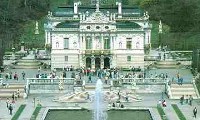 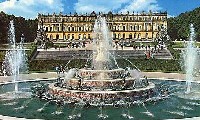
left: Eduard Reidel, Georg Dollmann and Julius Hofmann, Neuschwanstein, 1869-86, Bavaria.
center: Georg Dollmann, Linderhof, 1870-79, Bavaria.
right: Georg Dollmann, Julius Hoffmann and Franz Paul Stulberger, Herrinchimsee, 1874-86, Bavaria.
|
All history, then, is the history of thought, where thought is used in the widest sense and includes all the conscious activities of the human spirit. These activities, as events in time, pass away and cease to be. The architect re-creates them in his own mind: he does not merely repeat them, as a later scientist may re-invent the inventions of an earlier: he re-enacts them consciously, knowing that this is what he is doing and thus conferring upon this re-enactment the quality of a specific activity of the mind. This activity is a free activity. It differs toto caelo from the imitativeness which may induce a man or a beast to do what others do because these others are observed to be doing it. For the architect does not observe others to be doing the things which he does over again. Until he has done them over again he does not know what they are. It is only after I have grasped the idea of specific gravity that I can see what it was that Archimedes had done when he shouted Eureka: I am therefore in no sense imitating Archimedes.
R. G. Collingwood, The Idea of History (New York: Oxford University Press, 1994), p. 445.
| |
subliminal (philosophical) reenactments
2000.03.24 15:26
It just occurred to me that the notion of reenactment is an integral part of Western philosophy's very beginnings. Without being explicit about it, Plato nonetheless exercised reenactment in many of his texts. Of course, I'm referring to the Socratic dialogues first, the cave second.
footnotes:
Every ten years, the whole town of Oberammergau, Bavaria reenacts Christ's last week in Jerusalem, commonly known at the Passion Plays. This tradition has been an integral part of Oberammergau since the end of the Black Plague. Neuschwanstein and Linderhof are each just several miles from Oberammergau.
And how about all the reenacting the Pope's been passionately doing this week? What with reenacting Moses, Christ, and most interestingly, St. Helena.
|
A philosophical or pseudo-philosophical objection to the conception of the architect as re-enacting the past must here be met. It may be said that no such re-enactment is possible nothing can happen twice. Archimedes discovered the idea of specific gravity: I can know that he did so, but I cannot re-discover the idea, for discovery implies priority. The second person who thinks of the idea is not discovering it. Nor is this, it may be said, a merely logical distinction: for there is a peculiar quality in the experience of discovery or invention, a peculiar feeling of being the first human being to penetrate into the presence of this particular truth, which the architect can never recapture just because it attaches to discovery as such. Clearly, then, if the architect knows the past by reenacting it, he cannot re-enact this element of discovery or originality and therefore cannot know it historically: hence, from the view here maintained, the reductio ad absurdum follows that no discovery, no thought that is really original or unique (and what genuine thought is not?) can be historically known.
R. G. Collingwood, The Idea of History (New York: Oxford University Press, 1994), p. 445-6.
| |
Baroque ending (for sure)
2000.10.27 12:43
Although most of the current discussion at architecthetics deals more or less with theorizing of how 'style' (might) come to be, generally how things/styles emerge, I nonetheless offer the following as an example of how (a) style ends, in this particular case the Baroque style.
The following is a passage I first read over 23 years ago. It comes from Thomas K. Kitao, Circle and Oval in the Square of St. Peter's: Bernini's Art of Planning (New York: New York University Press, 1974), pp.22-23. I was reminded of this passage after some reflection upon the recent bit of cyber theater that occurred here at design-l [i.e., the email list I first sent this post to on 16 October 2000 -- design-l and architecthetics are the double theaters I play in] a month and a half ago.
"In the well know production of the Due Teatri, first given in 1637, Bernini developed a simulated amphitheater of a very elaborate kind. This is, of course, the best known of Bernini's theatrical works, but a recapitulation is in order.
According to Massimiliano Montecuculi, who witnessed the performance, the stage was prepared with "a flock of people partly real and partly feigned" so arranged that, when the curtain had fallen for the opening of the play, the audience saw on the stage another large audience who had come to see the comedy. Two braggarts, played by Bernini himself and his brother Luigi, then appeared on the stage, one facing the real audience and the other the fictitious; and recognizing each other in no time, they went on to claim, each in turn, that what the other saw as real was actually illusory, each firmly convinced that there was no more than one theater with its audience in that half he was facing. The confusions of realities in mirror image thus heightened, the two firmly decided "that they would pull the curtain across the scene and arrange a performance each for his own audience alone." Then the play was performed to the real audience, that is, the main act to which that preceded was only a pleasant prelude. But through the play another performance was supposed to be taking place simultaneously on the second stage introduced by Luigi; the play was, in fact, interrupted at times by the laughter from those on the other side, as if something very pleasant had been seen or heard.
At the end of the play, the two braggarts reappeared on the stage together to reaffirm the "reality" of the illusion. Having asked each other how they fared, the impresario of the fictitious performance answered nonchalantly that he had not really shown anything but the audience getting up to leave "with their carriages and horses accompanied by a great number of lights and torches." Then, drawing the curtain, he displayed the scene he had just said he had shown to his audience, thus rendering complete the incredible reversal of reality and illusion to the confused amazement of the real spectators, who were now finding themselves ready to leave and caught in the enchanting act of feigning the feigned spectators."
Here's my analysis:
Of course, the Baroque style continued beyond Bernini--I believe even the double porticos of St. Peter's Square were done after the above performance. All the same, Bernini's theatrical performance manifests the Baroque's consummate ending. Within his double theater Bernini capsulized the beginning of Western culture's new bifurcation of the real and the illusory, introduced mirroring as a henceforth dominant (post) Baroque (stylistic) theme, and, at base (or should I say at the ultimate end), inverted reality into a reenactment of its own illusory mirror (--is this perhaps also the genesis of historiography?).
Essentially, beyond the Baroque (and still often in our own modern times) architecture at its best is very sophisticated theater, keeping in mind that theater is one of the earliest forms of (man made) reenactment.
|
| |
|

 left: Venturi and Rauch, Franklin Court, 1972-76, Philadelphia. Here Benjamin Franklin's Philadelphia residence is reenacted rather than reconstructed. Although the site of Franklin's house is historically verified, the physical nature of the house is not recorded except for bits of archaeological evidence. The house is thus now presented in its true virtual condition.
left: Venturi and Rauch, Franklin Court, 1972-76, Philadelphia. Here Benjamin Franklin's Philadelphia residence is reenacted rather than reconstructed. Although the site of Franklin's house is historically verified, the physical nature of the house is not recorded except for bits of archaeological evidence. The house is thus now presented in its true virtual condition.








